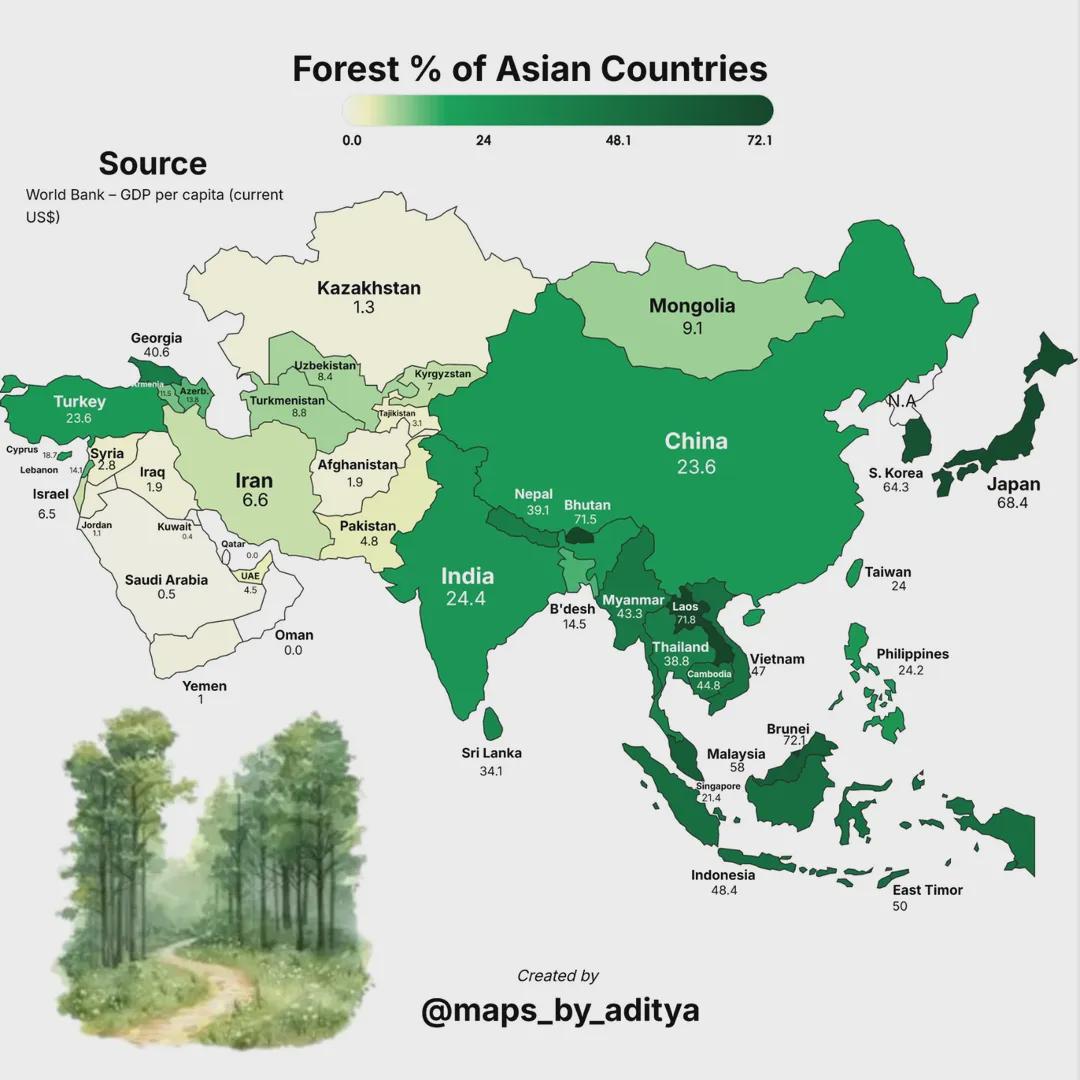Have you ever wondered about the lush green forests that stretch across vast expanses of Asia? A recent infographic shared by @maps_by_aditya offers a compelling visual insight into the forest-rich areas in Asian countries, measured as a percentage of total land area. Sourced from the
Have you ever wondered about the lush green forests that stretch across vast expanses of Asia? A recent infographic shared by @maps_by_aditya offers a compelling visual insight into the forest-rich areas in Asian countries, measured as a percentage of total land area. Sourced from the World Bank, this data does more than highlight statistics; it paints a vivid picture of the environmental significance of forests and the delicate balancing act between human development and nature conservation.
Forests are essential to maintaining ecological equilibrium, supporting biodiversity, and regulating global and regional climate patterns. Across many Asian nations, forests serve not only as natural habitats but also as critical sources of livelihood for indigenous and rural communities. Analysing the extent of forest cover in these countries provides valuable insights into their dedication to environmental sustainability, as well as the complex challenges they face in protecting these vital ecosystems.
The infographic presents a varied landscape, a mosaic of forest coverage percentages that reveal both remarkable preservation and concerning depletion. Countries such as Indonesia, home to some of the world’s most extensive rainforests, emerge as key guardians of regional green cover. In contrast, others facing ongoing deforestation issues underscore the urgent need for strengthened conservation policies and sustainable land management practices.
This data does more than highlight statistics; it paints a vivid picture of the environmental significance of forests and the delicate balancing act between human development and nature conservation.
Forests are essential to maintaining ecological equilibrium, supporting biodiversity, and regulating global and regional climate patterns. Across many Asian nations, forests serve not only as natural habitats but also as critical sources of livelihood for indigenous and rural communities. Analysing the extent of forest cover in these countries provides valuable insights into their dedication to environmental sustainability, as well as the complex challenges they face in protecting these vital ecosystems.
The infographic presents a varied landscape, a mosaic of forest coverage percentages that reveal both remarkable preservation and concerning depletion. Countries such as Indonesia, home to some of the world’s most extensive rainforests, emerge as key guardians of regional green cover. In contrast, others facing ongoing deforestation issues underscore the urgent need for strengthened conservation policies and sustainable land management practices.
The visual representation of forest cover percentages serves as a vivid reminder of the interconnectedness between nature, society, and policy decisions.
This renewed interest in environmental data highlights the power of visual storytelling in shaping public discourse. Infographics, like the one shared on Reddit, transform complex datasets into accessible insights, making it easier for people to connect emotionally with pressing ecological issues. When communities can visualise the scale of forest coverage or loss, it deepens understanding and can inspire action beyond digital platforms.
Moreover, the viral spread of such content demonstrates the role of online communities in amplifying awareness. Platforms like Reddit serve not just as spaces for commentary but as catalysts for education, collaboration, and even policy advocacy. When users engage with environmental data at this level, it becomes clear that digital engagement can translate into real-world environmental stewardship.
Educators, researchers, and campaigners can leverage these conversations to initiate broader discussions around climate change, land use policies, and conservation strategies across Asia and beyond. By encouraging local dialogues grounded in data, communities are more likely to advocate for sustainable land management and stronger environmental protections in their respective countries.
Ultimately, this intersection of open data, public interest, and community dialogue points to a hopeful shift: one where environmental responsibility is no longer limited to policymakers but is embraced as a collective mission. As the conversation continues, the challenge lies in transforming this shared awareness into consistent action that safeguards our forests, and our future.
As users engage with the content, they are not just passive viewers but active participants in a global dialogue on environmental stewardship and the preservation of our planet’s biodiversity.
This interactive exchange of ideas and perspectives amplifies the impact of the infographic beyond mere data interpretation, transforming it into a catalyst for environmental consciousness and advocacy within online communities.
Analyzing the broader trends illuminated by the forest cover percentages in Asian countries, we gain insights into the complex interplay of economic development, conservation policies, and climate change mitigation efforts. Countries that prioritize sustainable forest management practices demonstrate a commitment to long-term environmental resilience and biodiversity conservation. Conversely, regions experiencing rapid deforestation underscore the urgent need for collaborative strategies to address environmental degradation and habitat loss.
The juxtaposition of forest-rich and deforested areas in the infographic serves as a poignant visual narrative of the dual challenges and opportunities inherent in balancing human needs with ecological preservation.
It compels us to rethink our relationship with nature and consider alternative approaches to development that prioritize environmental sustainability and harmonious coexistence with the natural world. By examining these trends through a critical lens, we pave the way for informed decision-making and proactive measures to address pressing environmental concerns on a global scale.
In conclusion, the exploration of forest-rich areas in Asian countries through the lens of percentage data transcends numerical values to unveil a profound story of environmental interconnectedness, human impact, and collective responsibility. The infographic not only serves as a visual representation of forest cover but as a mirror reflecting our attitudes towards conservation, sustainability, and the legacy we leave for future generations.
Through continued engagement with such visual narratives and active participation in environmental discourse, we have the power to effect positive change, preserve our natural heritage, and nurture a sustainable future for all life on Earth.
As we navigate the complexities of a rapidly changing world, let us heed the lessons embedded in the forests’ silent greenery and strive to be stewards of the Earth, mindful of the interconnected web of life that sustains us all.




Leave feedback about this